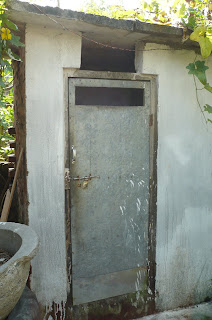Our reality ;I relate more to the Buddhist philosophy and you could perceive what we are doing as a ‘suffering’ considering how we live in NZ . Many all our familiar pleasurable desires, including those sensual are now extinct ; supping on fine wine ( in detox since being in Nepal) , eating French cheese, turning on the stereo at the end of a day’s travel and then sharing an intimate moment with each other ( we are still newly weds you know! ) Now.... At night time after a day of deciphering the language, wondering what you have ordered to eat and if the cup of water you have just been offered is safe to drink , finding a toilet and managing not to pee on your feet, surviving the transport near misses, the changes in climate and extreme heat , all our your energy depleted we crash into “bed” or a very hard version of one without a mattress ( more like a table) , exhausted ! Add to this cocktail of romance a cold shower , the sweet music of the mosquitoes buzzing around your ears , instead of my husband’s loving words , and the only thing crawling around the bed is a bug or two! Romance takes on a new meaning and sleep is a much more attractive option ! Untouchable, definitely, however Nirvana is in sight,........ we hope!
What is Buddhism ?
Buddhism is not a religion since it is centred not one a god but a system philosophy and code or morality .It was first founded in northern India on about 500BC when a prince called Siddaratha Gautama achieved enlightenment . He was actually the fourth , the birth of the first Buddha was actually in Nepal. Buddha believe that enlightenment is the goal of all beings and eventually we will all reach Buddhahood.
There are 2 main Buddhist schools.
The Theravada ( Doctrine of the Elders ) or Hinayana, holds the path to Narvana the eventual aim of all Buddhist, is an individual pursuit. In contrast the Mahayana school holds that the combined belief of its followers will eventually be great enough to encompass all of humanity and bear it to salvation .( some people call this the ‘soft option” ! ) There are other versions of Buddhism found in Nepal one is l called the Tantric Buddhism of Tibet .
Buddha taught that all life is suffering and this comes from our sensual desires and the importance of these . He initially renounced material life in search of enlightenment but as this did not lead to discovery he developed a more realistic rule “ Moderation in all things”. Thats me! By following the ‘eightfold ‘ path our desires will be extinguished and a state of nirvana will be reached where our desires are extinct and we are free from our delusions . There are also as series of rebirths . Karma is the cycle that takes you through a cycle of births : your actions in one life determine the role you will play and what you have to go through in your next life.
What is Hinduism ( 80% of the population in Nepal )
This is the predominant religion in Nepal. This religion extends back 1000BC. The foundation of Hin dui philosophy explained in the holy book called the Vedas, the devine knowledge. Hindu’s believe that we all go through a series of re births or reincarnations that eventually lead to moksha, the spititual salvation that frees one from the cycle or rebirths .With each rebirth you can move closer to or futher away from eventual karma which is literally a law of cause and effect. Bad actions during your life result in bad karma , which ends in a lower reincarnation. Conversely , if your deeds and actions are good you will reincarnate to a higher level and be one step closer to the eventual freedom from rebirth. Dharma is the natural law that defines the social, ethical and spiritual harmony of your life.
There are 3 categories of Dharma.
1. External harmony that involves the whole universe
2. Dharma that controls castes and relations between castes
3. Moral code that follows that an individual should follow.
There are 3 main practices in the Hindu religion.
1. Puja/ worship.
2. The cremation of the dead.
3. Rules and regulations of the caste system.
There are 4 main castes
1. Brahmin /Chhetri or priest caste ( 65%)
2. Kshatriya or soldiers and governors
3. Vaisyas or trades people and farmers
4. Sudras or menial workers and crafts people .
These castes can then be subdivided although this is not taken to the same extreme as in India Beneath all castes are the Harijans or untouchables , the lowest caste casteless class for who the most menial and degrading tasks are reserved . You can not change your caste but if you choose to marry below your caste them according to Kedar you go down to that caste forgoing your previous higher caste status. From discussions we have had with local people the discrimination between the castes is lowly being ‘diluted” .
Ref: The Lonely Planet and Internet




































